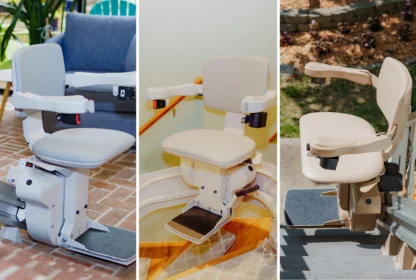
Let’s face it, most individuals will need to research a ramp at some point in their lives. Whether for a visiting friend, temporary use after surgery, an older relative who is struggling with stairs, an aging pet, or one of the numerous other scenarios, we will likely all find ourselves involved in the decision-making process. With so many different ramp options available, the selection process can become overwhelming, so the folks here at 101 Mobility have created a handy guide to help you choose the right ramp.
How Much Ramp do I Need?
The length of ramp required is dependent on the rise measurement – the measurement from the top step or landing to the ground. According to ADA guidelines, ramps should adhere to a 1:12 ratio, meaning for every one inch of rise, the ramp should extend 12 inches in length. For example, if a home has three steps off a front porch with a total rise measurement of 21 inches, it would require 21 feet of ramp length. The guidelines also require that ramps have a minimum width of 36″, as well as a level platform at the top and bottom. These guidelines help to ensure that ramps are safe for all users, with a reasonable slope and safe width – for more information, you can view the full ADA Ramp Guidelines here
Wood vs. Aluminum
The next step in selecting your ramp is determining which material to choose. Let’s see how the two most common materials stack up:
Price
Price is typically based on the length of ramp required and may vary by city, state, or region. To compare, we will look at prices for a ramp that is 30 feet long. According to Networx, a wood ramp built by a professional carpenter can cost anywhere from approximately $3,500 – $8,000 to build (not to mention additional costs to maintain the ramp, as wood needs to be re-stained every few years). With the proper tools and skill set, it is possible for some handy individuals to build wooden ramps on their own, which would certainly decrease the installation cost. However, many individuals are not qualified to perform this type of work, and would still encounter various costs regarding materials, permitting, and time spent on labor. Alternately, an aluminum ramp of the same length may cost anywhere from approximately $3,000 – $5,500 to have assembled and installed. Aluminum is very durable and requires minimal maintenance in most geographic regions.
Verdict: Aluminum ramps are often less expensive than their wood counterparts unless you are handy enough to build a wood ramp yourself
Time

Wood Ramps take two – seven days to build and require regular maintenance to replace boards
The time it takes to construct a ramp varies based on the material, length, and configuration required. Building a simple wood ramp of about 30 feet would take a contractor anywhere from two days to one week, including time spent pouring concrete, cutting and assembling the wood, and staining the ramp to protect it from the elements. Installing a 30-foot modular aluminum ramp takes less than one day, and can typically be completed within a just few hours.
Verdict: Aluminum ramps can typically be installed in a fraction of the time it would take to build a wood ramp of the same length
Maintenance
The large majority of ramps are outdoors, where they are exposed to the elements. If you have a wood ramp, you will have to clean the wood and reapply a stain or sealing product in order to protect it from moisture. Where the wood sits on the ground, it may be prone to decay due to the constant contact with a moist surface. Any decayed or broken pieces would have to be replaced in order to maintain the integrity of the ramp as a whole – often requiring future service calls with a carpenter! Conversely, aluminum is extremely durable and typically will not need to be replaced or repaired for many years. While there is a possibility that the ramp may settle and need to have bolts or screws tightened, these repairs can be taken care of quickly and inexpensively – many companies warranty their ramps, so any adjustments within the first year are often completely free!
Verdict: While both wood and aluminum ramps may require eventual maintenance, repairs to aluminum ramps are often faster and cheaper
Traction
Traction is very important for a ramp in order to enable wheelchair wheels to brake when needed or to ensure anyone walking or pushing a wheelchair on the ramp can maintain safe footing. Most aluminum ramps are manufactured with a grooved, non-slip surface that maintains sufficient traction, even during heavy rain. Alternately, wood planks used to build ramps are typically very smooth, as they have been handed down for use. Have you ever walked on a deck or other wood surface in the rain? Especially if the surface was not completely scrubbed clean from dirt and debris prior to the rain, it can become extremely slippery! This slick surface becomes even more treacherous when used at an angle, as with a ramp. In order to avoid slipping on a wood ramp, it must either be cleaned and maintained meticulously, requiring great deals of time and effort, or it must have a non-stick surface applied to the wood, adding additional expenses.
Verdict: Wood ramps can become extremely slippery, and require additional materials in order to match the level of traction that comes standard with a grooved aluminum ramp
Inclement Weather
Depending on where you live, your ramp might be exposed to heavy snow and ice, lots of rain and humidity, salty air, or a combination of all three! If you happen to have a wooden deck, then you are likely familiar with how the elements affect the surface, often requiring a new coat of stain each year to protect the wood. Experts do not recommend using regular rock salt on wood or metal ramps as they can corrode, so what can you do to keep your ramp safe for use throughout the winter? A simple and affordable solution that works with both wood and aluminum ramps is Magnesium Chloride, which you can purchase in large quantities at your local hardware store and simply sprinkle over the surface of your ramp. If you want to add additional traction to a ramp during slippery times, you can purchase an inexpensive bag of Kitty Litter to sprinkle over the surface! While keeping your ramp safe during inclement weather may require the same processes for both wood and aluminum ramps, a wood ramp will likely need to be re-stained or painted at the end of the winter, whereas an aluminum ramp can simply be hosed off to remove any leftover residue.
Verdict: Any outdoor surface may become slippery during heavy snow or ice, and will require snow and ice removal, but an aluminum ramp will remain safe during heavy rain whereas a wood ramp will become slick.
Purchase vs. Rent
Many times, a ramp will only be needed for a short period of time, whether it is while an individual is recovering from an injury or surgery, or a friend or relative who is visiting for a short period of time. In these instances, a ramp rental can provide a much more cost-effective means of getting the individual in and out of the home! Modular and portable aluminum ramps provide solutions for nearly any home, and are easily available for rental! Unfortunately, you will have a tough time trying to find a wood ramp available for rental, as they require such specific materials and extensive labor.
Verdict: Aluminum ramps are a great (and possibly only) solution for short-term needs!
Modular vs. Portable
What can you do if you have a friend or relative who visits your home frequently, but requires a ramp to get inside your house? Odds are, you do not want to purchase a ramp that will be permanently in place as you may only need it once every few months. This is a great time to consider Portable or Lightweight Ramps. These are ramps that are made of lightweight aluminum that can be laid down to provide temporary access. They are available in lengths from 2′ long to 12′ long and can be folded into smaller sections for easy transport and storage. These are also excellent products for those who use a wheelchair or scooter to have when traveling, in case a building is not readily accessible. Please keep in mind that the ADA Guidelines mentioned above do apply to portable ramps – never attempt to use a portable ramp in an unsafe manner!
Need additional help choosing a ramp? 101 Mobility’s trained product specialists to offer free on-site consultations and can help you choose the right length and type of ramp for your needs. Call (888) 258-0652 to speak with a Mobility Specialist today!
About 101 Mobility
101 Mobility is a full-service franchise business that specializes in mobility and accessibility equipment. Products include stair lifts, ramps, auto lifts, patient lifts, pool lifts, bath lifts, vertical platform lifts, and more.
101 Mobility franchisees are supplied with geo-specific online marketing campaigns, in-person training, on-going support, and a proprietary business management platform.
Visit 101Mobility.com to learn more and visit 101 MobilityFranchise.com to find more information about our franchise process.


